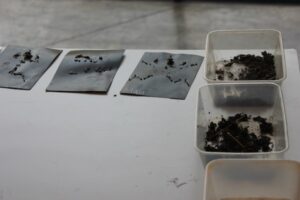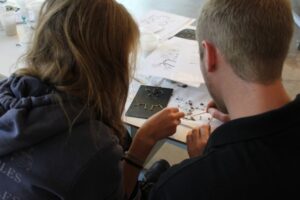Why is National Feed the Birds Day important?
National Feed the Birds day began in Edinburgh at 11am on 29 October 2011 at the West Gate of the Royal Botanic Garden Edinburgh. Nicola Bell, RSPB manager, said:- “This is the perfect time. The clocks are going back. We’re trying to encourage people not to lie in bed for an extra hour but to do something nice for the visitors in their garden.”
Activities at the Botanics during the day included arts and crafts and mini science lessons. Children and their parents were engrossed in dissecting pellets regurgitated by owls which contained the bones of small animals they had eaten. Events Assistant Neil Madigan aid:- “At first the kids are grossed out, but then they really enjoy it. It’s gross fun!”
One nine year-old girl described the process like this:- “I’m putting bones back together to see what animal it was.” “I’ve got another maggot!” her younger brother interrupted excitedly.
Workshops helped visitors to mix lard, oatmeal and dried fruit into bird cakes. Frozen ground in the depths of winter puts birds in danger of starvation. Nicola Bell urged people not to scatter white bread, which lacks nutrients, but to buy or make bird food. She explained that homemade bird baths, squirrel-proof feeders and bird houses were all important. Those who want to get involved in this winter’s push to help Edinburgh’s wildlife can find and share different bird seed recipes. The website also has tips for children on things to make and do.
 “I’ve been surprised how much people take it on around Edinburgh,” said Neil Madigan. “My local shop in Portobello had bird seed on sale with a sign saying Feed the Birds Day.”
“I’ve been surprised how much people take it on around Edinburgh,” said Neil Madigan. “My local shop in Portobello had bird seed on sale with a sign saying Feed the Birds Day.”But it is not just about one day for the RSPB, who try to maintain awareness in the city during winter months. Through winter ‘The Hobbits’ in the Hermitage of Braid Nature Reserve, and ‘The Newts’ in The Botanics encourage children aged 6-11 to explore urban wildlife and take part in activities like building homes for hedgehogs and sculpting crows for visitor centres.
In a new collaboration with BBC’s Live n Deadly, youngsters can also investigate their very own Crime Scene along a wildlife trail.
The RSPB presence at the Ethical Christmas Fair in Princes Street Gardens from 24 November 2011- 4 January 2012 will allow them to spread the word about the dangers facing birds in winter. January’s Big Garden Bird Watch will then ask the Edinburgh public to go out into the gardens and write down the numbers of birds they see.
Edinburgh is fertile ground for a spotting a vast array of birds. Several species have been on the rise in the city, including goldcrests, long-tailed tits and cole tits. The capital’s most common bird is the house sparrow, compared to the feral pigeon in Glasgow.
In the Botanics alone, sparrowhawks, kingfishers and great spotted woodpeckers can be sighted. Viewers watched drama unfold in BBC’s Autumnwatch coverage of sparrowhawk nests in Edinburgh’s Botanic gardens. Crows attacked and destroyed one stronghold but the other nest successfully hatched six eggs. Next year the West Gate in the park hopes to show members of the public the live hatching of sparrowhawk eggs.
Big plans are brewing for the charity in Scotland next year. Events Manager Sarah McDowell is planning the country’s first bird festival here. The Rutland Festival, the Glastonbury of the bird world, has been running in England for 22 years and attracts in excess of 20,000 visitors. She hopes Scotland’s festival would celebrate the country’s vast variety of native birds, from ospreys and capercaillies to starlings, numbers of which are in decline.
And here is a video showing you how to make your own bird food….
[vimeo 30181115 w=400 h=225]
Come dine with the birds from The RSPB on Vimeo.
